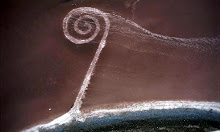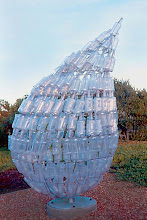Until today's class, we hadn't really considered site-specific art in other mediums besides artwork and performance pieces. However, as pointed out in discussion, site-specific art can be seen in other forms, such as literature. The Maximus Poems take place in Gloucester, Massachusetts, where Charles Olson also resided. Due to his familiarity with the place, Olson mentions many specific locaations--street names, neighborhoods, local businesses, neighboring cities--which add a level of site-specificity to his poems. Furthermore, due to the various arrangements of words within his poems, Olson creates a certain level of performance within the text. The poems explore a variety of different formats and compositions, using techniques such as indentations, single and double spacing between lines, prose and verse, sentence/line length variation, and even the shape in which the text lies on the page (straight lines of words as opposed to spiraling words on the page, such as in "Letter, May 2, 1959"). For this reason, there is a site-specific and performative aspect to the poem, which cannot be obtained through listening to or watching someone read the poems aloud. Though Olson himself has read the poems
aloud to an audience, the words seem to take on a different format when read and seen as opposed to heard. Without the layout of the words in front of you, The Maximus Poems lose a certain quality. Don Byrd, author of a critical commentary entitled Charles Olson's Maximus, comments that it "is a carefully made book, the juxtaposition of poem to poem sweeping the fragments into a dynamic form. The meaning is often in the interstices. Even blank pages become elements of the design." Similarly, George F. Butterick, one of the editors of The Maximus Poems, says: "Spaces between the lines and sections of the poems and blank pages...were very much part of the meter and rhythm of the book. Besides separating one untitled poem from another, these spaces and blank pages provide a balance of whiteness or its echoing effect, the measure of it, comparable to rests in music." From this, we can gather that a proper reading of the poems require the visual aspect of the texts due to the fact that the words of the poem find themselves site-specific to their location on the page.

References:
Butterick, George F. Editing The Maximus Poems: Supplementary Notes. Storrs: University of Connecticut Library, 1983. Print.
Olson, Charles. The Maximus Poems. Ed. George F. Butterick. Berkeley: University of California, 1983. Print.












No comments:
Post a Comment